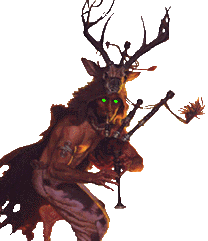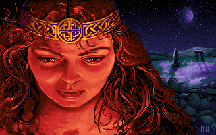

Seership is one of the Druid crafts of the Celtic tradition. This tradition has evolved over the centuries, and alongside this evolution the individual crafts within the Celtic system have themselves expanded and developed. This constitutes a perfectly natural progression, with each successive generation building on the knowledge and practises of its predecessors.

In this first of two articles on seership, I hope to show how such an evolution took place within the craft of the seer, from the early tribal shaman to the highly specialised craft of the Bronze Age Druidh. I shall also be looking at the importance to the seer of being in the right place, at the right time...
The origins of the craft of the seer lie far back in time in the early hunter/gatherer tribal communities. The shaman was the spiritual leader of the tribe. Such individuals were of the utmost importance, for the survival of the tribe depended on their giving assistance to the hunt. The shaman would journey in the Otherworld by means of 'Spirit Flight', invoking the aid of his totem animal which would become his eyes and ears in these realms. He would track down the exact location of herds for the tribe to hunt. The use of sympathetic magic was essential. We do not know exactly how such rituals were carried out, but they would probably have taken the form of offerings to the Lord of the Hunt, the Horned God, followed by a dramatic enactment of the hunt by the shaman, in full view of the hunters, culminating in the successful kill. This is probably the main purpose of the elaborate cave paintings found throughout Europe, depicting scenes from the hunt.
These early shamans/seers were usually men; this is not to say that women were not shamans, however the taboo on women being associated in any way with the act of the hunt was a strong one. Women were the givers of life and as such were highly valued by the tribe and carefully protected by the warriors/hunters to ensure the survival of the next generation. Nevertheless, each tribe would no doubt have had its midwives, medicine women, wise women and so on.
These early ancestors of ours lived in close proximity to the natural world; their survival was inextricably tied to the seasonal cycle, the fertility of the beasts of the hunt, the fertility of the land and the availability of fruits, roots, nuts and berries. It is therefore not surprising that they began to develop from close observation of the Green World, a complex system of signs, symbols and omens, built on and added to over time, drawn from the land around them. This subject alone, known as Natural Law, could fill a book. Suffice it to say that the craft of the seer evolved 'hand in hand' with this ever-increasing understanding of the workings and interactions of the natural world. Since the natural world, like everything else, operates according to the laws of Cause and Effect, it was possible to make accurate predictions of the future trends by study of natural events - the flight patterns of birds, the direction of the wind, the shape of clouds, the behaviour of wild animals and so on.
By the time of the Bronze Age the craft of the seer had developed into quite a fine art. From this time onwards the Druidhean (Druids), the priesthood of the Celts, had organised their study and learning into separate crafts, such as bard, magician, brehon, seer. Although a master Druid (ollamh) had to have studied all the priesthood crafts, at the same time each craft was by this time beginning to develop its own mysteries, symbolism, initiation rites and so on which were jealously guarded from 'outsiders'.

The gift of the seer is specifically named in the Tain Bo Cuailnge as the "imbas forasnai", the Light of Foresight. We are also told that the North of Alba was particularly associated with the training of seers. The word of the seer could not be questioned, even by kings or queens. In the Tain, Queen Medb of Connaught meets the seeress Fedelma. The queen asks how the forthcoming battle will go for her troops, to which the shocking answer is given thus: "I see it crimson; I see it red". Fedelma goes on to predict that all this will be the work of one man, Cuchulain.
The evolution of the priesthood crafts in general were greatly assisted by the economic and social changes of Celtic society, namely, the development of livestock and pastoral farming, together with the cultivation of crops such as oats and barley. These changes diminished the dependence of the tribe on the hunt, allowing the new priesthood to develop their skills in more metaphysical ways - the study of the moon and stars, the great Nineteen Year Calendar, the mapping and exploration of the Otherworld realms, the study of numerology, the magical and medicinal uses of plants, and so on. This great storehouse of knowledge began to be built up slowly, becoming the pursuit of knowledge for spiritual and magical purposes, no longer directly linked to the physical survival of the tribe.
The craft of the seer is one that by its very nature lends itself more readily to the emotive and intuitive part of the psyche. Hence it is a craft that women, on the whole, have a lot of natural feeling for. After all, you cannot train to 'become' a seer; the Sight has to be within you to begin with, ready to be developed and embellished. Despite this, it would seem from documented evidence that the majority of 'official'seers were men, and there are many Gods associated with seership, such as Fintan, Lir, Mongan and Manannan. Whereas many women were natural seers, few would have undergone the training necessary to hold the position of seer in the courts of kings and nobles. Women were more likely to stay within their own clan holdings, offering help to family and neighbours whenever the occasion called for their gift of the Second Sight. In other words, despite a few exceptions, women were the unofficial seers of the Bronze Age, whereas men were the diviners and augurers, undertaking complex rites and rituals to determine the destiny of kings and heroes.
For a great many reasons, the moon has always been closely associated in natural religions the world over with the feminine and the intuitive sides of nature. The moon rules the sky at night and gives us sight into the darkness and the unknown. The night is also the time of stillness and rest from the day's activities. The moon also rules the tides, and it is the element of water, and its reflective qualities in particular, that is such an important medium for scrying and divination.

The element of Air is also important to the seer. Whereas water is symbolic of the Otherworld, the realm of the Goddess and the source of all, Air is the means by which the seer travels through the two worlds to seek out signs. Air is the activating principle that carries forth the signs and symbols of the Otherworld into the consciousness, to allow the seer to make sense of what he or she has seen. We can imagine this as something akin to the flight of a bird. It is interesting that cloaks of birds' feathers were worn by seers. The greatest Irish seeress of Tara, Messbuachalla, was visited by a divine being in the shape of a great bird. All birds are important to the craft of the seer and there were certain taboos placed upon its followers concerning the killing or eating of birds. One of the most significant totem birds of the seer is the swan, for it is a bird of air, of water and of the land where they meet. The swan is also the form in which the divine race of the Tuatha De Danaans often take upon themselves.
Our picture of the craft of the seer begins to take shape. We have seen how the moon, water, air and birds are all associated with this craft. Another important aspect of seership is its association with "in between" states. This is what I meant by "being in the right place at the right time", which in the eyes of a Celt is the time and place of "no time, no place". Firstly, of "no time" - on a daily cycle we have the in between times of dawn and dusk. These are very potent magical times for they are neither day nor night, but are on the threshold of both, and you can never quite capture when they begin or end. On a monthly cycle we have the times of the Full and New moon; at these times the moon is neither waxing nor waning, yet it contains the flow of both . Finally, on a yearly cycle, we have the two great festivals of Samhain and Beltaine. At all these times that are "no time", the two worlds come together in a brief embrace - time enough for the seer to travel between the veils.
Secondly, we have the places that are of "no place". They are the points where the two dimensions meet, such as doorways, fords, and the shoreline. The trained seer will make use of all these keys, to travel freely between the worlds and gain access to the knowledge he seeks in other realms. Such times and places are also, however, fraught with dangers for the seer, who must take action to ensure protection from harm and a safe return journey.
Thursday, December 26th, 2019
Attention visitors: Tartans.com is back. Please note that this is a snapshot of the site as it existed nearly 20 years ago and you may encounter broken links; we are still combing through the site and correcting those as we find them. Please also note that some sections are currently not functional, primarily the discussion forums/clan chat boards.
|
** HOME - First Time Visitors - Glossary - - Contact Us ** Awards | Bibliography | Clan Calendar | Clan Chat | Clan Finder | History | Famous Scots | Genealogy | Great Hall of the Clans | Links | News and Features | Scots on the Net | Search | Site Map The Gathering of the Clans
Copyright 1995- Tartans.com - All Rights Reserved. |